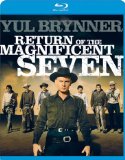“How would you like to use that gun belt for something more than just holding up your pants?”
Although the title of the blu-ray is Return of the Magnificent Seven, the original film’s title sequence just calls it Return of the Seven, and for good reason. There is nothing vaguely magnificent in this movie. This is the type of sequel that gives sequels a bad name.
Yul Brynner is the only original cast member to return, even though the three surviving members of The Seven return as lead characters in this story. Brynner insisted Steve McQueen not be involved, due to McQueen’s perceived upstaging of him in the first film. So the role of Vin went to Robert Fuller, who like McQueen was a staple of TV westerns. Fuller obviously goes out of his way not to steal the scenes from Brynner and his performance is stiff and dull. Likewise, Horst Buchholz didn’t reprise his role as Chico and the role went to Spanish actor, Julian Mateos. Brynner makes sure Chico’s role didn’t balloon into a center focus as in the original, keeping the character off screen for the majority of the film.
The story is a lazy reprisal of the first film, which itself was a Hollywood reimagining of a Japanese masterpiece from Akira Kurosawa. Brynner’s Chris is called back to save the original Mexican village from yet another small army of outlaws. He once again must quickly assemble team of hired guns, train the simple villagers how to defend themselves and fight even more outnumbered battles leading to the sacrifice of most of his team. Instead of robbing the villagers of their food and goods like before, the outlaws are capturing the men of the village (including Chico) and using them for slave labor. Apparently leaving the women of the village alone and unmolested to practice bizarre rituals of synchronized laundry washing.
The great Mexican actor/director Emilio Fernandez plays the villainous Lorca, leader of the outlaws. He may not bring the style and energy of Eli Wallach’s Calvera, but he does infuse the role with a violent, natural machismo. Fernandez, a renowned director in Mexico, once shot a critic in the balls for slamming his films, killed a farm laborer in a gunfight and escaped a Mexican prison to avoid serving a 20 year sentence, fleeing to California where he began his career in American films. Probably best known for his role as the general in The Wild Bunch, Fernandez rode as an unaccredited bandit in Calvera’s gang in The Magnificent Seven.
The three new members of The Seven include the great Warren Oates as Colbee, a disturbingly women obsessed philanderer bordering on rapist, Claude Akins plays Frank, a brooding man haunted by a dark past and Virgilio Teixeira as Luis, the lustful Latin lover turned dangerous Mexican gunslinger. Of these three, only Oates seems to embrace his role with relish. Akins seems half crocked the entire movie and Teixeira isn’t given enough to define his character beyond first impressions.
Larry Cohen (It’s Alive, Q, Maniac Cop) wrote the screenplay. Even though the film is half an hour shorter than the first, it moves at a glacial pace. There simply are no iconic lines and a noticeable lack of pacing and tension. Director Burt Kennedy was obviously influenced by Sergio Leone’s Spaghetti Westerns and occasionally achieves an effective sequence here and there, but for the most part lacked an eye for action or iconic set pieces. Production moved from Mexico, due to all the heat from government censors during the first film and was shot in Spain, making the Mexican village and its surroundings appear radically different from the original.
Video:
The film is presented in 1080p/AVC MPEG-4 with a 2:35:1 aspect ratio running an average of 30mbps. Unlike its predecessor, the original print was not cleaned up and shows a great deal of scratches, dust and speckling throughout, although the second half of the film is noticeably in better shape. Details vary greatly, much of the film is soft, especially during stock footage, but most close ups are sharp. Grain is evident, with DNR artifacts and noise common in the negative spaces. Colors and black levels vary from scene to scene, but for the most part the blacks lack saturation and the colors are slightly washed out.
Audio:
Elmer Bernstein returns to score the movie which led to an Academy Award nomination (making up for criminally overlooking the original soundtrack masterpiece), but score doesn’t integrate fully with the film and feels piecemeal. The English DTS-HD MA 5.1 audio track is very flat, somewhat tinny and still front heavy due to the audio design, although slightly more immersive than the previous film, but. The soundtrack to dialog levels are off, forcing you to ride the volume to follow the dialog and not be deafened by the music or SFX.
Special Features:
The only special feature is the trailer (2:35, HD). Whomever MGM had building their trailers should have been taken outside and shot.
Final Thoughts:
It’s hard to understand how Hollywood took six years to develop this sequel and got it so wrong. They missed the opportunity to revisit The Magnificent Seven from a fresh angle. They ignored director John Sturges’ formula of gathering the hottest young action stars and encouraging them to compete before the camera. Hell, they didn’t even get Steve McQueen to reprise his wonderfully nuanced role of Vin. This is just sloppy, opportunistic film making at its worst. The resulting movie isn’t horrible, just banal and clichéd. I would recommend The Return of the Magnificent Seven only to completists looking to collect the entire Magnificent Seven saga.
“We got to stand alongside of ’em so that someday they can stand alone.”





